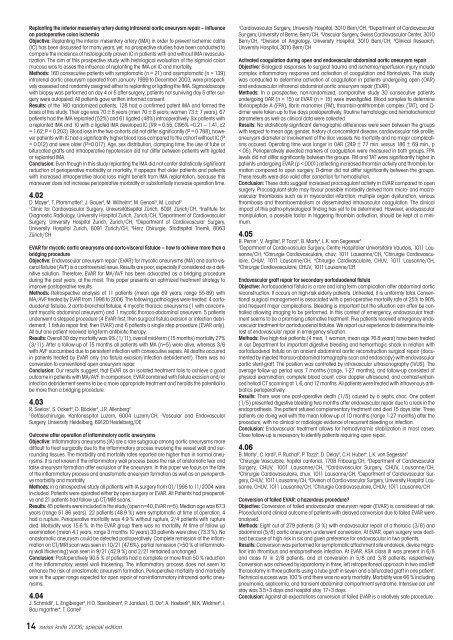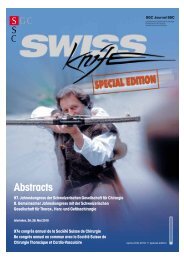Abstracts 4. Gemeinsamer Jahreskongress der ... - SWISS KNIFE
Abstracts 4. Gemeinsamer Jahreskongress der ... - SWISS KNIFE
Abstracts 4. Gemeinsamer Jahreskongress der ... - SWISS KNIFE
You also want an ePaper? Increase the reach of your titles
YUMPU automatically turns print PDFs into web optimized ePapers that Google loves.
swissknife spezial 06 12.06.2006 13:39 Uhr Seite 14<br />
Replanting the inferior mesentery artery during infrarenal aortic aneurysm repair – Influence<br />
on postoperative colon ischemia<br />
Objective: Replanting the inferior mesentery artery (IMA) in or<strong>der</strong> to prevent ischemic colitis<br />
(IC) has been discussed for many years; yet, no prospective studies have been conducted to<br />
compare the incidence of histologically proven IC in patients with and without IMA revascularization.<br />
The aim of this prospective study with histological evaluation of the sigmoid colon<br />
mucosa was to asses the influence of replanting the IMA on IC and mortality.<br />
Methods: 160 consecutive patients with symptomatic (n = 21) and asymptomatic (n = 139)<br />
infrarenal aortic aneurysm operated from January 1999 to December 2003, were prospectively<br />
assessed and randomly assigned either to replanting or ligating the IMA. Sigmoidoscopy<br />
with biopsy was performed on day 4 or 5 after surgery; patients not surviving day 5 after surgery<br />
were autopsied. All patients gave written informed consent.<br />
Results: of the 160 randomized patients, 128 had a confirmed patent IMA and formed the<br />
basis of this study. Their age was 70 ± 8 years (men 70 ± 8 years; women 73 ± 7 years). 67<br />
patients had the IMA replanted (52%) and 61 ligated (48%) intraoperatively. Six patients with<br />
a replanted IMA and 10 with a ligated IMA developed IC (RR = 0.55, CI95% =0.21 – 1.41; c2<br />
= 1.62; P = 0.203). Blood loss in the two cohorts did not differ significantly (P = 0.788), however<br />
patients with IC had a significantly higher blood loss compared to the cohort without IC (P<br />
= 0.012) and were ol<strong>der</strong> (P=0.017). Age, sex distribution, clamping time, the use of tube or<br />
bifurcated grafts and intraoperative hypotension did not differ between patients with ligated<br />
or replanted IMA.<br />
Conclusion: Even though in this study replanting the IMA did not confer statistically significant<br />
reduction of perioperative morbidity or mortality, it appears that ol<strong>der</strong> patients and patients<br />
with increased intraoperative blood loss might benefit from IMA replantation, because this<br />
maneuver does not increase perioperative morbidity or substantially increase operation time.<br />
<strong>4.</strong>02<br />
D. Mayer 1 , T. Pfammatter 2 , J. Gauer 3 , M. Wilhelm 4 , M. Genoni 5 , M. Lachat 3<br />
1 Clinic for Cardiovascular Surgery, Universitätsspital Zürich, 8091 Zürich/CH, 2 Institute for<br />
Diagnostic Radiology, University Hospital Zurich, Zurich/CH, 3 Department of Cardiovascular<br />
Surgery, University Hospital Zurich, Zurich/CH, 4 Department of Cardiovascular Surgery,<br />
University Hospital Zurich, 8091 Zurich/CH, 5 Herz Chirurgie, Stadtspital Triemli, 8063<br />
Zürich/CH<br />
EVAR for mycotic aortic aneurysms and aorto-visceral fistulae – how to achieve more than a<br />
bridging procedure<br />
Objective: Endovascular aneurysm repair (EVAR) for mycotic aneurysms (MA) and aorto-visceral<br />
fistulae (AVF) is a controversial issue. Results are poor, especially if consi<strong>der</strong>ed as a definitive<br />
solution. Therefore, EVAR for MA/AVF has been advocated as a bridging procedure<br />
during the past years, at the most. This paper presents an optimized treatment strategy to<br />
improve postoperative results.<br />
Methods: Retrospective analysis of 11 patients (mean age 69 years; range 55-89) with<br />
MA/AVF treated by EVAR from 1998 to 2006. The following pathologies were treated: 4 aortoduodenal<br />
fistulae, 2 aorto-bronchial fistulae, 4 mycotic thoracic aneurysms (1 with concomitant<br />
mycotic abdominal aneurysm) and 1 mycotic thoraco-abdominal aneurysm. 5 patients<br />
un<strong>der</strong>went a stepped procedure (4 EVAR first, then surgical fistula excision or infection debridement;<br />
1 fistula repair first, then EVAR) and 6 patients a single step procedure (EVAR only).<br />
All but one patient received long-term antibiotic therapy.<br />
Results: Overall 30 day mortality was 9% (1/11), overall mid-term (15 months) mortality 27%<br />
(3/11). After a follow-up of 15 months all patients with MA (n=5) were alive, whereas 3/6<br />
with AVF succumbed due to persistent infection with consecutive sepsis. All deaths occurred<br />
in patients treated by EVAR only (no fistula excision/infection debridement). There was no<br />
conversion to conventional open aneurysm repair.<br />
Conclusion: Our results suggest, that EVAR as an isolated treatment fails to achieve a good<br />
outcome in patients with MA/AVF. In comparison, EVAR combined with fistula excision and/or<br />
infection debridement seems to be a more appropriate treatment and heralds the potential to<br />
be more than a bridging procedure.<br />
<strong>4.</strong>03<br />
R. Seelos 1 , S. Ockert 2 , D. Böckler 2 , J.R. Allenberg 2<br />
1 Gefässchirurgie, Kantonsspital Luzern, 6004 Luzern/CH, 2 Vascular and Endovascular<br />
Surgery, University Heidelberg, 69120 Heidelberg/DE<br />
Outcome after operation of inflammatory aortic aneurysms<br />
Objective: Inflammatory aneurysms (IA) are a rare subgroup among aortic aneurysms more<br />
difficult to treat surgically due to the inflammatory process involving the vessel wall and surrounding<br />
tissues. The morbidity and mortality rates reported are higher than in normal aneurysms.<br />
It is not known if the inflammatory wall process bears the risk of anstomotic tear and<br />
false aneurysm formation after exclusion of the aneurysm. In this paper we focus on the fate<br />
of the inflammatory process and anastomotic aneurysm formation as well as on perioperative<br />
morbidity and mortality.<br />
Methods: In a retrospective study all patients with IA surgery from 01/1995 to 11/2004 were<br />
in-cluded. Patients were operated either by open surgery or EVAR. All Patients had preoperative<br />
and 21 patients had follow up CT/MRI scans.<br />
Results: 45 patients were included in the study (open n=40, EVAR n=5). Median age was 67.3<br />
years (range 51 86 years). 22 patients (48.9 %) were symptomatic at time of operation, 4<br />
had a rupture. Perioperative mortality was <strong>4.</strong>9 % without rupture, 2/4 patients with rupture<br />
died. Morbidity was 15.6 %. In the EVAR group there was no mortality. At time of follow up<br />
examination (mean <strong>4.</strong>1 years, range 3 months 10 years) 33 patients were alive (73.3 %). No<br />
anastomotic aneurysm could be detected postoperatively. Complete remission of the inflammation<br />
on CT/MRI scan was seen in 10/21 (47.6%), partial remission (>50 % of inflammatory<br />
wall thickening) was seen in 9/21 (42.9 %) and 2/21 remained unchanged.<br />
Conclusion: Postoperatively 90.5 % of patients had a complete or more than 50 % reduction<br />
of the inflammatory vessel wall thickening. The inflammatory process does not seem to<br />
enhance the risk of anastomotic aneurysm formation. Perioperative mortality and morbidity<br />
was in the upper range expected for open repair of non-inflammatory infrarenal aortic aneurysms.<br />
<strong>4.</strong>04<br />
J. Schmidli 1 , L. Englberger 2 , H.O. Savolainen 3 , P. Jandus1, D. Do 4 , A. Haeberli 5 , M.K. Widmer 5 , I.<br />
Bau mgartner 4 , T. Carrel 2<br />
14 swiss knife 2006; special edition<br />
1 Cardiovascular Surgery, University Hospital, 3010 Bern/CH, 2 Department of Cardiovascular<br />
Sur-gery, University of Berne, Bern/CH, 3 Vascular Surgery, Swiss Cardiovascular Center, 3010<br />
Bern/CH, 4 Division of Angiology, University Hospital, 3010 Bern/CH, 5 Clinical Research,<br />
University Hospital, 3010 Bern/CH<br />
Activated coagulation during open and endovascular abdominal aortic aneurysm repair<br />
Objective: Biological responses to surgical trauma and ischemia/reperfusion injury include<br />
complex inflammatory response and activation of coagulation and fibrinolysis. This study<br />
was conducted to determine activation of coagulation in patients un<strong>der</strong>going open (OAR)<br />
and endovascular infrarenal abdominal aortic aneurysm repair (EVAR).<br />
Methods: In a prospective, non-randomized, comparative study 30 consecutive patients<br />
un<strong>der</strong>going OAR (n = 15) or EVAR (n = 15) were investigated. Blood samples to determine<br />
fibrinopeptide A (FPA), fibrin monomer (FM), thrombin-antithrombin complex (TAT), and Ddimer<br />
were taken up to five days postoperatively. Routine hematologic and hematochemical<br />
parameters as well as clinical data were collected.<br />
Results: No statistically significant demographic differences were seen between the groups<br />
with respect to mean age, gen<strong>der</strong>, history of concomitant disease, cardiovascular risk profile,<br />
aneurysm diameter or involvement of the iliac vessels. No mortality and no major complications<br />
occured. Operating time was longer in OAR (249 ± 77 min. versus 186 ± 69 min., p<br />
















